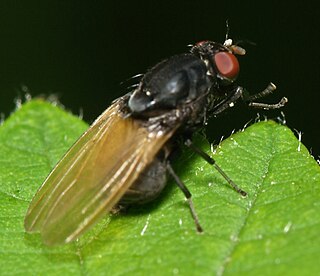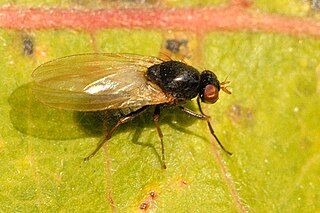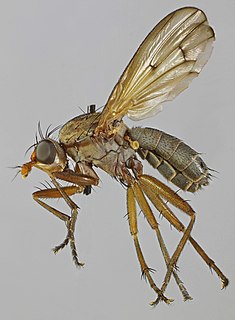Eurychoromyia mallea, the broad-headed fly, is a species of flies in the subfamily Eurychoromyiinae.

The Lauxaniidae are a family of acalyptrate flies. They generally are small flies with large compound eyes that often are brightly coloured in life, sometimes with characteristic horizontal stripes, such as in Cestrotus species. Many species have variegated patterns on their wings, but in contrast they generally do not have variegated bodies, except for genera such as Cestrotus, whose camouflage mimics lichens or the texture of granitic rocks.

The Chamaemyiidae are a small family of acalyptrate flies with less than 200 species described worldwide. The larvae of these small flies are active and predatory and are often used for biological control of aphids, scale insects, and similar pests. Chamaemyiid fossils are poorly represented in amber deposits, but a few examples are known from the Eocene epoch onwards.

The Celyphidae, commonly known as beetle flies or beetle-backed flies, are a family of flies. About 115 species in about 9 genera are known chiefly from the Oriental and Afrotropic biogeographic regions with one lineage in the New World.

Ochthera is a genus of flies in the family of shore flies (Ephydridae). The genus is distinctive because of the swollen raptorial forelegs. The larvae are predaceous on midge larvae while the adults feed on midges and mosquitoes. The genus is found around the world with about 37 species. The species Ochthera chalybescens has been shown to prey on African malaria vectors.

Homoneura is a genus of small flies of the family Lauxaniidae.

Minettia is a genus of small flies of the family Lauxaniidae. They have almost worldwide distribution, is one of the most species rich genera of the family with more than 120 described species. The Palaearctic is the most diverse with some 56 described species. The genus is divided into 3 subgenera.

Ocydromia is a genus of hybotid flies.

Calliopum is a genus of small flies of the family Lauxaniidae.
The broad-headed flies is a subfamily of flies. Until 2010, they were known from only one species based on four specimens and placed in the family Eurychoromyiidae.

Meiosimyza is a genus of small flies of the family Lauxaniidae.

Sepedon is a genus of flies in the family Sciomyzidae, the marsh flies or snail-killing flies.
Cestrotus elegans is a species of brachyceran flies in the family Lauxaniidae. It is found in Ethiopia and Morocco.

Tetanocera is a genus of marsh flies, insects in the family Sciomyzidae. There are at least 50 described species in Tetanocera.
Trigonometopus is a genus of flies in the family Lauxaniidae. There are more than 20 described species in Trigonometopus.

Xenochaetina is a genus of flies in the family Lauxaniidae. There are about 11 described species in Xenochaetina.
Eurystratiomyia is a genus of flies in the family Lauxaniidae.
Physegeniopsis is a genus of flies in the family Lauxaniidae.












